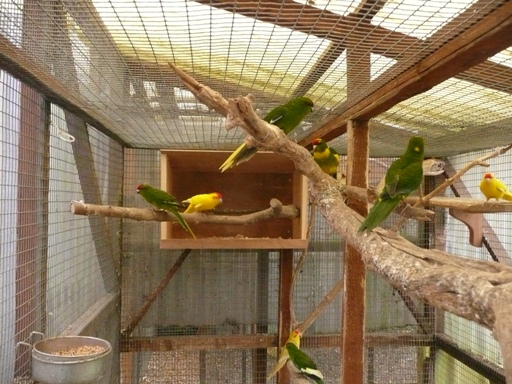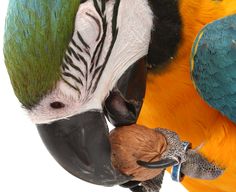I often get phone calls from people asking about having mixed flights with various different birds in there: Can I have this bird with this bird? Will they be ok? Will this work?
There aren’t really any set rules on which species can go together, but there are guidelines that can help you in this situation.
Many years ago, when Raymond Sawyer was alive, he had aviaries around his house with all sorts of different species together, when most people would say you can’t do that as they will fight. But he was a brilliant bird man and he knew his birds very well and he would study them. You often find you can put different species together, especially outside of the breeding season. The problem comes when you’ve got say a large aviary with softbills in it, with starlings, ground birds such as Plovers and Touracos and all sorts of exotic birds. They can be fine outside of the breeding season, but as you come into the breeding season you need to make sure that there is plenty of food available, and that food is available in several different places so that the large birds and the small birds are not going to the same area to feed. You also need to ensure that there is adequate places for all the birds to nest. Basically what you are trying to do is to avoid confrontation between the birds. It is very easy for one pair of birds to start claiming a territory in the aviary and this can cause problems. So in these situations, someone like Raymond Sawyer would study these birds very closely. If one bird or perhaps one pair of birds was disrupting the aviary, they would get moved to somewhere else and really it’s this sort of studying of the birds that makes the difference.
With other species of birds like parrots, you can have several different species in an aviary. I can remember in the days of Birdworld we created a very large aviary and in this aviary we put species of cockatoos, macaws, amazons, african greys… all sorts of different parrots together. When you do this, again you have to keep a very close eye on the situation. If you’ve got breeding pairs in there they can cause problems if they mark a territory and the other birds draw close, but if there are plenty of nestboxes and plenty of feeding stations it can be ok.
It is very common in these situations for one bird, perhaps who is weaker than the other birds, to get picked on. You have to watch the situation closely and remove any birds that may be getting picked on. At the same time at the other end of the scale, you can have a situation where you have an extremely dominant bird or pair of birds and in order to have a mixed enclosure of parrots, these may also have to be removed.
Once you’ve kept an eye on it and you’re in the breeding season, you can be fairly sure that everything is ok. It is always a good idea to have plenty more branches in there, especially around the feeding stations so that there is plenty for the birds to do, to land on and to chew and to keep them very, very busy all the time.
There is nothing more wonderful than having an aviary full of different birds in it.
I can remember another aviary in Birdworld in the seashore walk where there were all sorts of plovers, oyster catchers, spoonbills, night herons, and many other different birds together. It all worked very well but occasionally in that aviary you would have a bird become very tame. More than once we had oyster catchers, who can be fairly tame (especially when the general public are walking around all the time), become very tame – and a very tame bird sometimes can be picked on by the other birds. Whether this is a jealousy thing, or whether they become too humanized, I’m not quite sure but it’s something else you have to be watchful for.
Also in a mixed aviary of softbills, like the seashore walk, you will need planting to provide different areas so that the birds can get away from each other. This all has to be taken into consideration. There is a lot of experience required to produce an aviary for mixed birds. For many years I travelled around the world, designing aviaries for this purpose. Aviaries where you can view the birds and enjoy the magnificence of these creatures, but at the same time have an environment where the birds can breed, be happy and will not fight. This is difficult to explain over the phone, but hopefully these guidelines will help you if you want to go down that path of having a mixed aviary because indeed a mixed aviary in your garden is much more interesting and wonderful to see than aviaries of just one species of birds. You do have to watch how they interact but the interaction between them, if it’s not violent or a problem, can make a wonderful display and often mixed birds in an enclosure can breed very well indeed. Perhaps it’s a more natural way of keeping birds, but the mixed aviaries that we had in Birdworld did work extremely well.
Any questions about this, please do not hesitate to contact myself, I will be glad to help.
01252 342533
rob@robharvey.com











